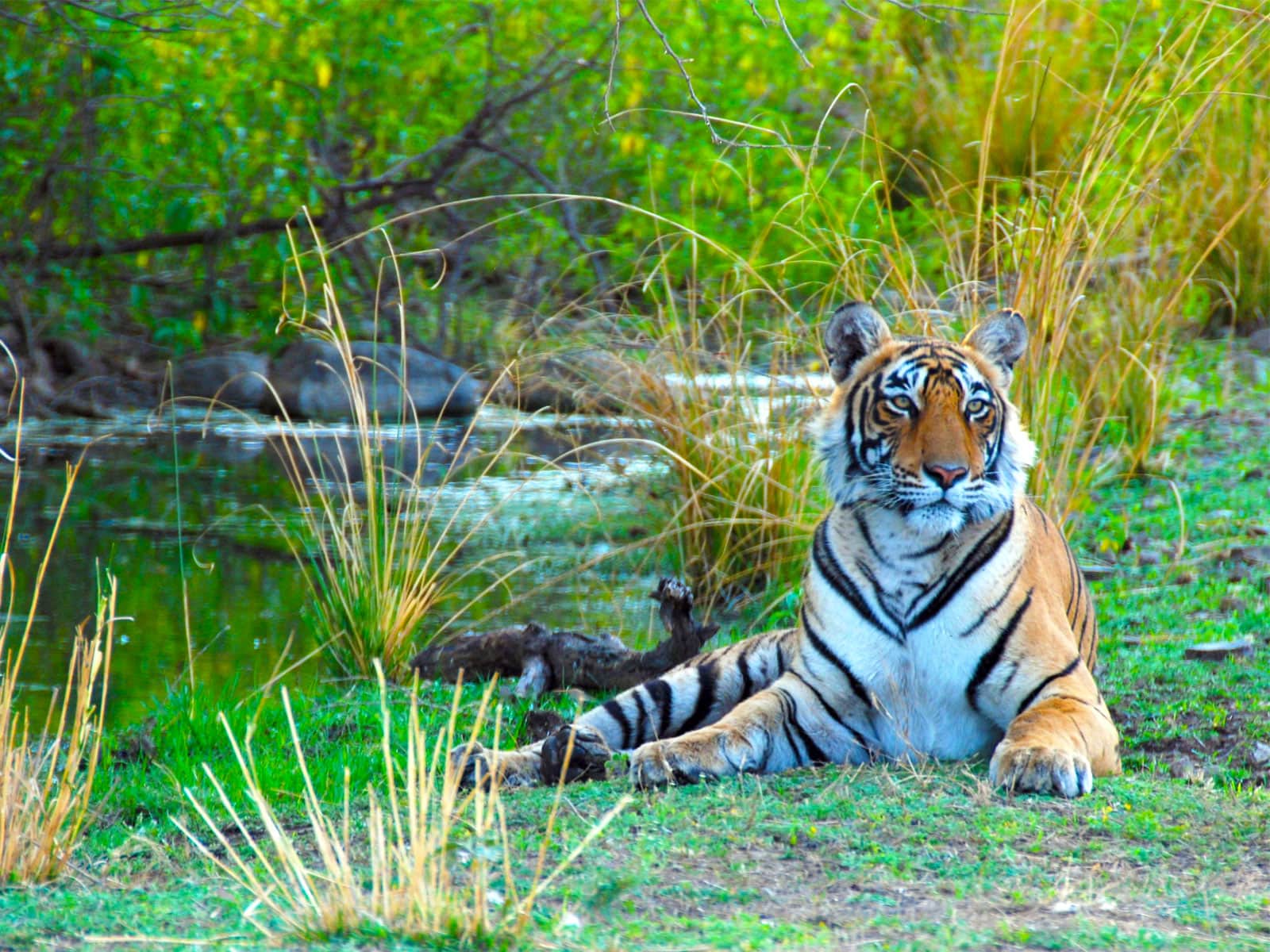
If you are want to travel with family, friends or are looking forward to having some invigorating moments nothing can be better than planning a vacation to the jungles to see the wildlife be it adventure, relaxation or exploration; Rajasthan has it all. From scenic and picturesque landscapes, to the beauty of deserts the wild life has a different hue. Apart from this Rajasthan gets foreign visitors every year that fly from one side of the earth and arrive Rajasthan. When birds get their perfect get away here in Rajasthan then it’s a must see visit for any individual who is fond of travelling and bird watching. Photographers come here to capture these beautiful creations and observe them. So here are a few places any wild life enthusiast would love to visit and capture the mesmerizing and bewitching charms of nature. Rajasthan, known for its vast deserts and royal palaces, is also home to a diverse array of wildlife and bird sanctuaries. These protected areas provide a haven for various species, both resident and migratory, making Rajasthan a unique destination for wild life and admirers of nature. Here’s a glimpse into some of the notable wildlife and bird sanctuaries in the region:
Desert National Sanctuary, Jaisalmer
Situated close to Jaisalmer, the Desert National Sanctuary is spread over 3162 sq.km area, and is one of the largest national parks in India. Despite its desert landscape, this wildlife bird sanctuary boasts of a diverse avifauna; it is a paradise for bird watchers and photographers. Some of the most common bird species you can find here are laggard falcons, spotted eagles, buzzards, kestrels, sand grouse, great Indian bustard, and more.
You will also find a collection of animal and plant fossils which are more than 100 million years old. The best time to visit this national park is between October and March.
Mount Abu Wildlife Sanctuary
In the heart of the rugged and beautiful Aravalli mountain ranges, the Mount Abu Wildlife Sanctuary is one of the most popular tourist places in Rajasthan. this lovely and exquisite piece of nature is home to many trees, plants, animals and birds. An array of flora and fauna can be seen and experienced here.
It’s a heaven for bird watchers a, poets, photographers and all those who find solace in the lap of nature. you love bird watching, this place is a paradise for you. you can watch more than 250 bird species. Some of the most commonly spotted species are grey jungle fowl, spotted eagles, and vultures. Apart from birds, you can also spot a variety of wild animals such as pangolin, wild boar, hyenas, hedgehogs, mongoose, porcupines, and if you are lucky, you can even spot the royal Bengal tigers and leopards.
Gajner Wildlife Sanctuary
Bikaner is one of the most popular cities in Rajasthan known for its colourful culture. But, the city is also home to unique flora and fauna, which you can find at Gajner Wildlife Sanctuary. The sanctuary was once a private hunting grounds for the Maharajas of Bikaner. Today, it attracts many nature lovers and those who like to explore the wildlife in the desert. Some of the birds and animals that you can spot here are antelope, nilgai, desert fox, wildfowl, golden oriole, bulbuls, doves, kingfisher and more.
Khichan Bird Sanctuary
Located about 170 kms from Jaisalmer in a small hamlet known as Khichan, this is one of the few exclusive bird sanctuaries in Rajasthan. This sanctuary is home to many local and migratory birds. Every year, between October and March, many migratory birds from Poland, Kazakhstan, Mongolia, North and South Africa come here in large numbers to escape the cold weather in Europe. The Khichan Bird Sanctuary is also popularly known as Demoiselle Crane village.
Ranthambore National Park
One of the most popular wildlife sanctuaries in India, the Ranthambore National is a popular tourist destination in Rajasthan. Nature lovers and wildlife lovers from all over the world come to Ranthambore to see its exotic flora and fauna. The major attraction at the park is the Jeep Safari, which takes you in the heart of the jungle and along the way you can spot many wild animals, including the Royal Bengal Tigers, and leopards.
The sanctuary is located about 10 kms from Sawai Madhopur, and is divided into 10 different zones, each of which are home to many tigers. During your safari, you can also see a wide variety of plants and trees as well as historical structures such as Raj Bagh ruins.
Apart from the wild animals, you can also spot a variety of birds at Ranthambore National Park, including partridge, golden backed woodpecker, peafowl, golden oriole, bulbul, peacocks, and more. So, there you have a list of the best bird sanctuaries in Rajasthan. Take your pick, and head off to a fun vacation in the wild.
Sariska Tiger Reserve
Sariska Tiger Reserve is well nestled in the Aravali Hills covering 800 sq km area divided into the grasslands, dry deciduous forests, sheer cliffs and rocky landscape. Whether you want to have camel safaris, go out for shopping in the surrounding places, visit medieval palaces or wildlife watching; Sariska Wildlife Sanctuary is the best place for you.
Nearly 90% of the area in the sanctuary is covered with dhok trees accommodating various wildlife species. A variety of other wild animals like the leopard, sambhar, chital, nilgai, four-horned antelope, wild boar, rhesus macaque, langur, hyena and jungle cats are found in the Sariska Tiger Reserve apart from the tiger. The Sariska National Park is home to India’s largest population of peafowl, and harbours quail, sand grouse, golden- backed woodpeckers and crested serpent eagles, among other species. Also the Siliserh Lake on the edge of the park has a large number of crocodiles.
The Sariska Wildlife Sanctuary houses the ruins of medieval temples of Garh-Rajor that date back to the 10th and 11th centuries. Also a 17th century castle on a hilltop at Kankwari provides a panoramic view of flying vultures and eagles. The Sariska was declared a sanctuary in 1955 and attained the status of a National Park in 1979.
Sariska park is home to numerous carnivores including Leopard, Wild Dog, Jungle Cat, Hyena, Jackal, and Tiger. These feed on an abundance of prey species such as Sambar, Chitel, Nilgai, Chausingha, Wild Boar and Langur. Sariska is also well known for its large population of Rhesus Monkeys, which are found in large numbers around Talvriksh.
A rich and varied birdlife here include Peafowl, Grey Partridge, Bush Quail, Sand Grouse, Tree Pie, Golden backed Wood Pecker, Crested Serpent Eagle and the Great Indian Horned Owl.
In conclusion, the wildlife and bird sanctuaries of Rajasthan stand as testament to the state’s commitment to preserving its rich natural heritage. From the royal Bengal tigers of Ranthambore National Park to the graceful Siberian cranes of Keoladeo National Park, Rajasthan offers a diverse and captivating range of flora and fauna. These sanctuaries not only serve as vital habitats for endangered species but also contribute to the overall biodiversity of the region.
The unique ecosystems within these sanctuaries, ranging from the desert landscapes of Desert National Park to the lush surroundings of Mount Abu Wildlife Sanctuary, showcase the adaptability of wildlife to diverse environments. Visitors have the opportunity to witness nature’s wonders, whether it’s the regal presence of a tiger, the graceful flight of migratory birds, or the resilience of species in arid conditions.
Moreover, these sanctuaries play a crucial role in ecotourism, attracting nature enthusiasts, researchers, and tourists from around the world. The conservation efforts and initiatives undertaken in these protected areas underscore the importance of balancing human activities with the preservation of natural habitats.
As we celebrate the beauty and diversity of Rajasthan’s wildlife and bird sanctuaries, it is essential to recognize the ongoing challenges in conservation. Continued efforts in habitat protection, wildlife monitoring, and community involvement are imperative to ensure the sustained well-being of these ecosystems.
Ultimately, Rajasthan’s sanctuaries provide not only a glimpse into the wonders of the animal kingdom but also a reminder of the interconnectedness between human societies and the natural world. Preserving these sanctuaries is not just a commitment to biodiversity but a pledge to future generations to inherit a planet teeming with the awe-inspiring beauty of its wildlife.















